Hoo Ness Yacht Club,
Vicarage Lane,
Hoo,
Rochester,
Kent
ME3 9LB
Clubhouse: 01634 250052
Email: memsec@hooness.org.uk
A Lock Too Far
This article appeared in the 2010 MYA Yearbook. It is reproduced here to encourage Medway yachtsmen to venture upstream for a pleasant and surprising change of scene.
Like most Medway yachtsmen I had never ventured upstream of Rochester Bridge, which bars the passage of most sailing boats, and had caught only occasional glimpses of the beautiful non-tidal river above Allington Lock, near Maidstone.

Dulali and tender at East Farleigh Lock
Without her mast, Dulali, my 40-year-old Contessa 26, was like a bird with clipped wings. The little stub mast that I made to hold the VHF antenna, burgee and steaming light only served to emphasise the deformity but the transformation of yacht into motor boat was essential for this trip.
Few sailing yachts can pass under Rochester Bridge and many of the older bridges further upstream have less than nine feet of headroom. With the help of friends at Hoo Ness Yacht Club, which has a mast crane, Dulali’s mast was lifted off and stored for the duration of this trip and a subsequent voyage up the Thames to Oxford.
The 11 nautical mile tidal section of the river from Rochester Bridge to Allington Lock, near Maidstone, is the responsibility of the Medway Ports Authority. Charted (low tide) depths in much of this section are less than a metre, and the tidal current is strong, so good timing is essential.
From Allington Lock, the 19 statute miles to Tonbridge have nine more locks. According to the Environment Agency’s user guide for the non-tidal Medway, boats like mine with 1.2 metre (4 ft) draught can reach Tonbridge “under normal conditions”. This did seem optimistic but was confirmed with a phone call to the EA. In July 2009, recent rain meant that the water level was near the top of the lock gates. I took heart from the fact that some years ago fellow yachtsman, Wil Pretty, got to Tonbridge with a fin-keeled yacht of 1 metre draught. However I took the precaution of towing a dinghy with an outboard engine in case I got stuck.
Hoo to Allington (14 nautical miles)
Slipping my mooring at Hoo, two hours before high water at Chatham, left me two and a half hours to get to Allington Lock at high water there. Beyond the slightly scary Rochester Bridge I got a great view of Rochester Castle with the cathedral behind it. Marinas dominated by motor boats line the river for several miles upstream of the bridge, which has been the lowest crossing point since Roman times.

Rochester Bridge
South of Rochester the river passes through the Medway Gap, which it cut into the chalk of the North Downs over millions of years. In awe I gazed up at the lofty trio of bridges carrying the M2 motorway and Channel Tunnel Rail Link. At Halling, a village on the outside of a sweeping bend, I was surprised to see a new-looking floating pontoon with a yacht on it. Through the bushes on the east bank near Burham I glimpsed the Hawkwood Stone, which marks the traditional limit of jurisdiction of the Mayor of Rochester, celebrated each summer by the Admiral’s Cruise to Sheerness and back.
Seen from the road, this area seems dominated by scrap-yards, paper mills and derelict industrial sites but, from the river, it seems mostly rural and positively idyllic; old churches, meadows, woods and reeds line the banks. The rising tide covers any hazardous and unsightly debris at the river edges but it is advisable to keep near the middle.
Neolithic tombs nearby testify to long-gone peoples of the Medway valley. At Aylesford, Saxon brothers Hengist and Horsa fought the Britons in the year 455. Horsa was killed and the white prancing horse or stallion (hengst in German) became the symbol of Kent. In 839 King Alfred fought the Danes here.
Just before Aylesford the attractive ragstone walls of the restored friary back directly onto the river. After another bend, the old town with its eight-arched picturesque medieval bridge (2.8m clearance at HWS) came into view. The Little Gem in Aylesford, dating from 1105, is the smallest pub in Kent but there’s nowhere to moor so I just had to imagine the real ale on offer there.
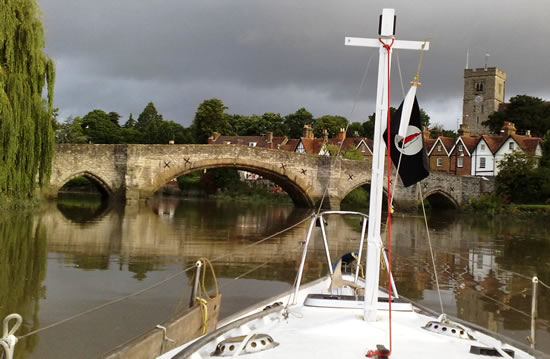
Aylesford Bridge
From Aylesford to Allington I slowed down to dodge floating debris of all kinds brought by the tide. To my growing consternation, doors, huge baulks of timber, a large blue chemical drum and even what looked like a fire extinguisher floated past. Masses of floating reeds masked the hazardous debris. Most of these objects were still there on my return a few days later.
After passing under the M20 motorway bridge and past a boatyard on the west bank, Allington Lock appeared before me. All the way from Hoo I had not passed another moving vessel and the lock was also deserted. Approached slowly, I prepared my fenders and mooring lines. Suddenly the friendly lock-keeper, Steve, appeared and briskly opened the huge gates for me to go straight in. This is the only manned lock on the Medway and is electrically operated. The tide had now reached its peak so the water gushing into the lock only raised my boat a few feet. Minutes later I was in the lock-keeper’s office handing over £25 for a one-week visitor’s licence. In return I received a handsome user guide with much useful information, especially about using the locks and the lifting bridge at Yalding. The guide also includes pretty maps which would be more useful if the locks were clearly marked on them.
Allington to Maidstone (2 miles)
I had come prepared with a borrowed windlass handle to operate the locks, otherwise I would have had to buy one for £18 at Allington Marina. I had also borrowed a key to operate the lifting bridge at Yalding, which would have cost me £8 from the lock-keeper. Oddly I thought, neither item is available for hire. I later found out that the same key also unlocks the toilet at Yalding, which would have been nice to know beforehand. Among other equipment I brought were mooring pins, like big metal tent pegs to secure the boat to the river bank, and a plank for stepping ashore or perhaps receiving royalty on board. Apart from the lock handle, which was essential, the rest went unused.
There is a speed limit on the non-tidal Medway of 5 knots but Dulali would not exceed this without a struggle. Up to Maidstone the river is supposed to be able to accommodate boats with 2m draught but Dulali’s echo sounder warning went off just yards after emerging from Allington Lock, so for peace and quiet I adjusted the warning limit from 2m to 1.3m. This was not a good omen of things to come.
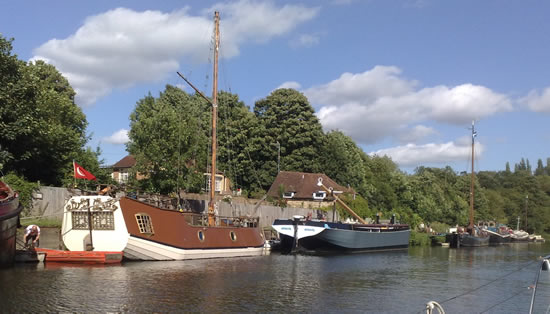
Barges at Allington
Though pleasant overnight moorings were available at Allington Lock, across the river from the huge and popular Malta Inn, I had a few hours to spare and carried on to find the free moorings in Maidstone. This two-mile, attractively wooded stretch has become the new Millennium River Park and there are several new footbridges. The park opened in 2001; how ironic! The banks just above Allington Lock are lined with large Dutch barges, some with tall masts in place. Even without masts it beggars belief that they could pass under the 14th century stone bridge at Aylesford. A little further on, Allington Marina is in a secluded and pleasant spot and the nearby castle, which is closed to the public, can be glimpsed through the trees.

Free moorings at Fairmeadow, Maidstone
Approaching Maidstone town, I noticed the banks were lined with private moorings all with intimidating notices. After the railway bridge, a throng of motor cruisers lined the free council moorings at Fairmeadow, in anticipation of the annual river festival as I later discovered. Aiming for a gap between two large cruisers by House of Fraser, I came to a premature halt just short of the paved bank with the keel bumping gently on the hard weedy bottom. There were no bollards or cleats, so I tied up to the friendly neighbours’ mooring rings. Apparently Maidstone council expects you to bring your own mooring rings which are threaded into metal sockets in the paving. There was nothing about this in the EA user guide, but, hey, the mooring was free and just across the road from the town centre and station. On arrival at the toilet block a few yards away near Maidstone New Bridge, a council official was locking it up long before its advertised closing time of 8pm.
Maidstone was the head of navigation until 1746 when it was made navigable as far as Tonbridge. Until Allington Lock was built in 1792, the river was tidal up to East Farleigh. Sailing barges moored on the quay below the old bridge in Maidstone and sailors thronged the streets. Much of Kent’s agricultural produce went to London and some to the Continent from here.
Maidstone to East Farleigh (2.5 miles)
Traffic from the busy road and worry about grounding kept me awake much of the night. However the neighbours were right to assure me that the water would rise an inch or two overnight. In the morning I met my daughter and her friend at the nearby station and with little ado Dulali set off up the river under the two road bridges, past the medieval Archbishop’s Palace, through the suburb of Tovil and onwards towards East Farleigh.

Into the unknown
Among the trees overhanging the river from both sides, anglers anxiously watched their almost invisible lines as we passed. To our right we could see the railway which runs parallel to the river all the way to Tonbridge. Suddenly there was a bump which I felt through my feet! The two-and-a-half ton boat shuddered as the keel stuck something hard, even though we were in the middle of a straight section of the river, at this point supposedly suitable for boats half a metre deeper in draught than Dulali. Angular rocks were visible at the water’s edge, an uncommon sight in the south-east of England. The river south of Maidstone crosses the heavily wooded Greensand Ridge, the source of the Kentish ragstone used for building the ancient bridges and churches of the Medway valley. I had not expected us to be dashed on the rocks so soon.
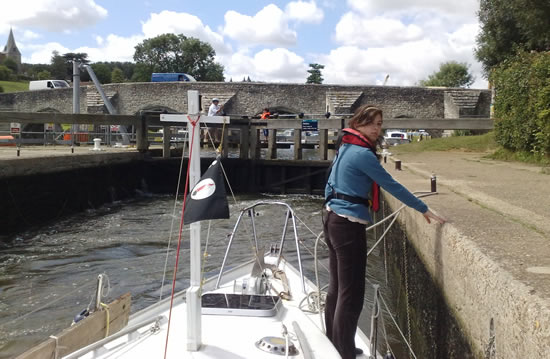
East Farleigh Lock and Bridge
East Farleigh lock is the first of nine manually-operated locks on the river, 4.5 miles from Allington Lock. It is overlooked by a pretty village with a church and an ancient stone bridge with a clearance of 2.55m, just like most of the other old bridges on the river. Beside the lock is a large weir, safely fenced off by a string of orange floats. The ten sections between locks are referred to as “pens” varying from 0.75 to 4.5 miles in length.
East Farleigh to Teston (2 miles)
The two mile pen from East Farleigh to Teston (pronounced “Teeson”) was uneventful and pleasant. As we meandered though woods and meadows, we looked in vain for somewhere to moor for lunch. The moorings at East Farleigh, as elsewhere on the river, were all occupied with motor cruisers that looked like they rarely if ever moved. At one point, we saw what looked like a mooring stage and approached the bank, only to retreat quickly to the middle of the river when the echo sounder went mad. On closer inspection we saw signs saying “private fishing” and “no mooring”.
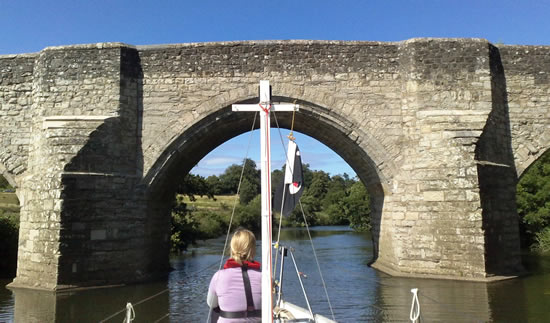
Teston Bridge
The picturesque Teston Bridge, just below Teston Lock, was built by monks in the 14th century. The central arch was enlarged when the river was upgraded for navigation in the mid eighteenth century. Teston church and village overlook the river from higher ground on the south side of the lock.
Teston to Yalding (3 miles)
Just above Teston is a country park on the north bank, very handy if you want to stretch your legs or find a loo. A mile or so further west, at Wateringbury, there is a station and more boatyards that call themselves marinas but there’s nowhere for a visitor to stop.
As the river emerges from the greensand hills it curves to the south-west through more pretty meadows and woods, with trees falling into the river, before there is a fork where motor boats are moored on numerous little jetties. The natural river bends to the left (south-east) but the navigation channel goes straight on into a narrow canal.
On our first trip we took the left fork towards the village of Yalding. After a few hundred yards, just past the entrance to a caravan park- cum-marina called Little Venice, Dulali came to crunching halt in the middle of the river. I distinctly felt the cockpit floor rise under my feet as we stopped. No amount of reverse engine thrust would get us off the gravel shoal. The map showed we were a little downstream of the confluence with the River Beult. Making the best of the situation, we just unpacked our lunch and had a picnic. Afterwards we loaded some heavy kit and ourselves into the dinghy, to lighten the boat, and pulled Dulali backwards off the shoal. It took a strong pull from the outboard but after a few seconds, she came free, surged backwards a little faster than I intended and crashed into the branches of a tree, breaking off the ensign staff.
Back to Allington Lock
By this point it was apparent that we were not going to get to Tonbridge that day, so after lunch we returned to Maidstone where I saw my daughter and her friend off at the station. This time I decided to stay the night at Allington Lock where the secluded and very pleasant EA moorings cost £5 per night and there is a new shower block (shower £1 extra). Though all the overnight moorings were occupied by boats, no other crew could be seen and I had the ablution facilities to myself.
On our way back, when approaching East Farleigh we saw a man with a light blue Environment Agency shirt waving at us from the south bank. As we then passed under the bridge we realised why: a small motor cruiser was drifting towards the weir, beyond the reach of Dulali with her limited manoeuvrability. By the time we had tied up Dulali in the lock, fitted the outboard engine to the dinghy and arrived on scene, the cruiser was already being held by the current against the string of orange floats above the weir. I towed the cruiser to the bank where the man in the blue shirt had indicated. The cruiser was then taken in tow by another boat which promptly crushed its gantry into the underside of the bridge with expensive-sounding crunching noises.
The next day, with fresh crew consisting of Gordon Pickett and his daughter, we repeated the attempt to reach Tonbridge. Gordon is very knowledgeable about birds and extremely observant, so my ornithological education was advanced somewhat. I had not noticed the kingfishers and birds of prey until Gordon pointed them out.
Hampstead Canal
On this second attempt to reach Tonbridge, we went straight on into the narrow canal, which leads to Hampstead Lock. Large motor cruisers line the south side of the canal suggesting a good depth of water but almost immediately we felt the boat slow down as the keel trailed in the soft mud. By increasing engine power and staying strictly to the middle of the channel we managed to keep going.
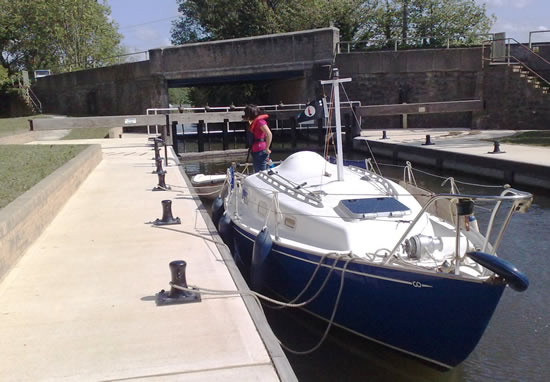
Hampstead Lock
Hampstead Lock, recently renovated, is noticeably bigger and deeper than the other two we had passed; the User Guide warns about operating the sluices slowly to avoid turbulence. After a bend where the canal passes under a bridge, the canal runs for 500 yards alongside Hampstead Lane towards a small lifting bridge.
Dulali’s engine struggled to push the keel through the soft mud and several times we came to a halt. The EA guide claims that boats with 1.7m draught (0.5m greater than Dulali’s) can reach this point but we concluded that it would be unwise to proceed further. Ironically we reached this conclusion at the EA compound where their dredger is moored, just before the lifting bridge.
The electrically-operated lifting bridge has pushbuttons and clear instructions. Our key would have allowed us to operate the bridge or enter the toilet in the fenced compound, but it went unused.

Lifting bridge and the Anchor pub at Yalding
The thatched Anchor Inn serves decent food and has a pleasant terrace overlooking the river. Across the ancient Twyford Bridge, not to be confused with nearby Yalding Bridge which is the longest stone bridge in Kent, is Teapot Island. It’s hard to imagine another country where a collection of teapots would be a tourist attraction but we had an ice cream there and it was a pleasant diversion before retracing our track back to Allington Lock.
Almost as soon as Gordon and his daughter departed, Wil Pretty turned up. As mentioned above, years ago he had succeeded in getting all the way to Tonbridge in a yacht with a one-metre keel. As it began to rain, we enjoyed an evening boat ride to Maidstone and back before dining at the Malta Inn.
Next morning Steve Flower, the senior lock-keeper at Allington, kindly opened the lock an hour early to allow me to return to Hoo in time to get ashore from my river mooring at half-tide. It was a bit of a rush but I just made it.
Postscript
Medway Ports Authority is supposed to remove the hazardous debris in the river downstream of Allington Lock but without commercial traffic they have little incentive. They have not responded to my report.
The GPS coordinates of the position where Dulali first hit something hard, half a mile downstream of East Farleigh lock, was reported to the EA, who marked the spot with yellow buoys (see Medway Navigation Notice to Mariners No 8, 2009). A dredging contractor was appointed to clear this and other shallow spots that I reported.
Was this trip a failure? Well, it was a disappointment not to have reached Tonbridge, my intended destination, but Dulali had seen enough of this delightful river to recommend other yachtsmen to venture upstream in her wake.
Dulali is now owned by another member of HNYC but I still look wistfully at her on her river mooring.
More Information
Official Environment Agency website for the River Medway
http://www.visitrivermedway.co.uk/
Other Environment Agency website for the River Medway
http://www.environment-agency.gov.uk/rivermedway
Medway User Guide (free from EA when registering at Allington Lock)
http://216.31.193.170/static/documents/Leisure/medwayguidecomplete_690099.pdf
Site run by the lock-keepers at Allington
http://www.allingtonlock.co.uk
Medway River Users Association
http://www.mrua.co.uk
Maidstone River Festival
http://www.maidstoneriverfestival.com
Table of distances on the River Medway
http://www.jim-shead.com/waterways/river.php?wpage=MEDW
History and geography fact-sheet for the Medway
http://www.ukcanals.net/medway.html
Date Published 7th Jan 2012


 Follow us
Follow us Tweet us
Tweet us